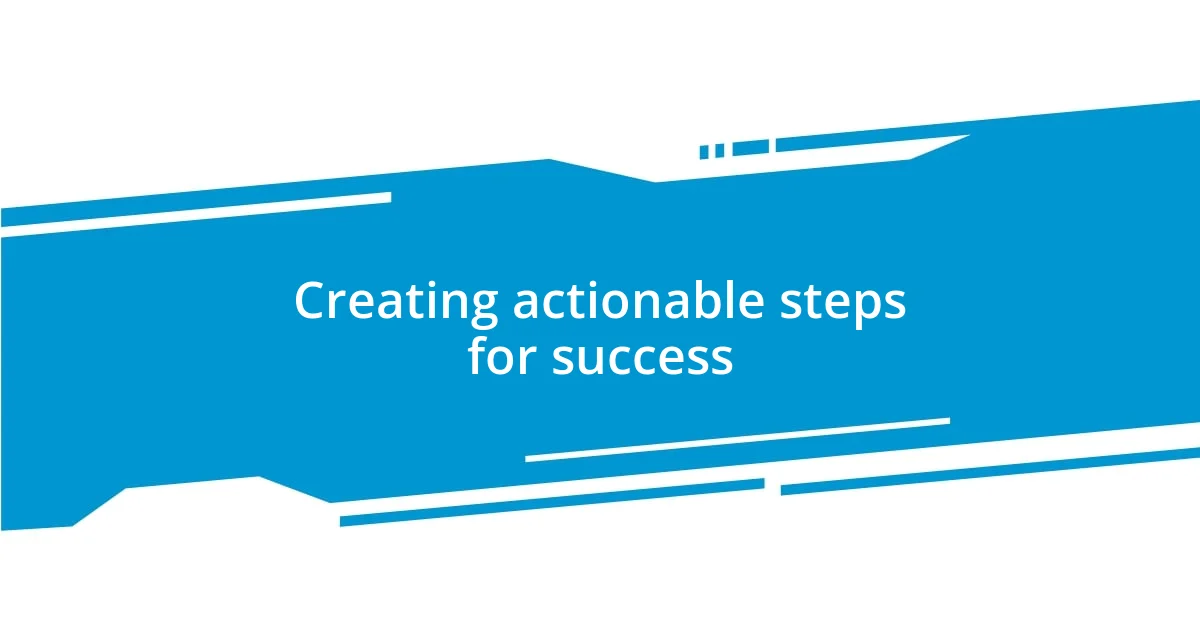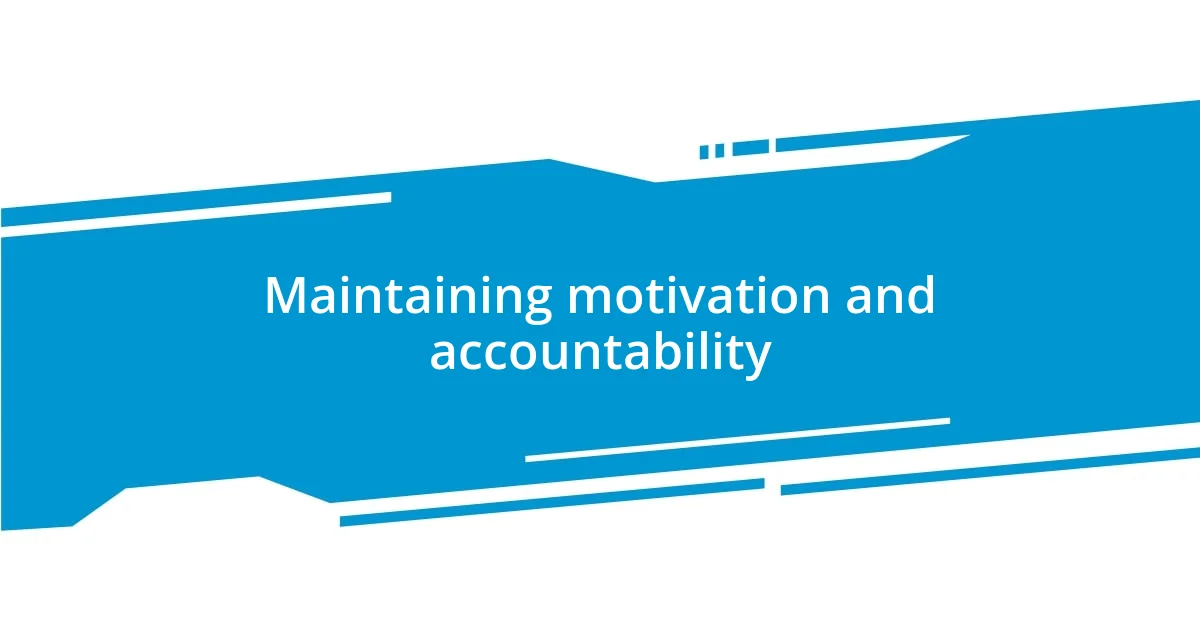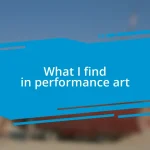Key takeaways:
- Setting specific and SMART goals provides direction, focus, and emotional connection to an artist’s creative journey.
- Regular reflection on achievements enhances self-awareness, allowing artists to appreciate growth and adjust goals as needed.
- Establishing accountability through routines, social sharing, and community support fosters motivation and encourages the celebration of milestones.

Understanding the importance of goals
Goals are like a compass for an artist; they guide and inspire direction in our creative journeys. I remember a time when I felt completely lost in my art, floundering between projects without a clear vision. Setting specific goals shifted everything for me—it transformed that overwhelming feeling into tangible milestones, making my progress feel significant.
Have you ever experienced the exhilaration of accomplishing a goal? For me, completing a series of paintings for an exhibition was a turning point. The excitement of seeing my vision come together gave me a renewed sense of purpose and deepened my passion for creating. Goals not only provide focus but also nurture our emotional connection to our craft, fueling our drive to explore new ideas.
It’s also fascinating to consider how goals break down the often intimidating aspects of being an artist. When I set small, achievable objectives, like mastering a specific technique or participating in a local art show, I found myself more engaged and motivated. Each achievement, no matter how small, creates a ripple of confidence that propels us forward. Isn’t it empowering to think that by simply defining our aspirations, we can unlock our fullest potential?

Identifying personal artistic vision
When it comes to identifying my personal artistic vision, I often find that it requires deep self-reflection. I take time to ponder what truly resonates with me—whether it’s the themes I’m drawn to or the emotions I want to evoke in my audience. There was a period when I realized that my work felt disconnected from my true self, which led me on a journey of exploration. I started keeping a journal of my thoughts, inspirations, and the art that moves me, which helped to illuminate the path I wanted to follow.
Here’s a quick list of steps I found helpful in clarifying my artistic vision:
- Explore Your Inspirations: Create a mood board or digital collage of art that inspires you. Look for patterns in style, color, or themes.
- Reflect on Your Experiences: Write down moments in your life that have deeply affected you. This can reveal underlying themes that are worth exploring in your work.
- Define Your Message: Ask yourself what you want your audience to feel or think after experiencing your art. Crafting a mission statement can be powerful.
- Experiment and Evolve: Give yourself permission to try different styles and mediums to see what resonates most authentically with you.
- Seek Feedback: Share your work with trusted friends or fellow artists who can provide constructive criticism, helping to refine your vision.
Engaging with these steps has helped me cultivate a clearer perspective as an artist, prompting me to create work that truly represents who I am.

Setting SMART goals for artists
Setting SMART goals is a game changer for any artist. The SMART framework stands for Specific, Measurable, Achievable, Relevant, and Time-bound. For instance, instead of simply wanting to “improve my painting skills,” a SMART goal would be “to complete one painting a week that explores a new technique for the next two months.” This clear structure not only outlines what I want to achieve but also conveys the steps required to get there.
In my journey as an artist, I found that measuring progress is crucial. When I first exhibited my work, my goal wasn’t just to show my art but to gather feedback. I aimed to receive five pieces of constructive criticism from viewers during the exhibition. Reflecting on this experience, I recognized that setting measurable objectives greatly enhances accountability, keeping me motivated and focused on growth.
I’ve also learned that flexibility is key, especially in our creative processes. Goals can be adjusted as we evolve as artists. For example, after initiating several smaller projects, I realized I needed to prioritize my mental health. So, I redefined my goal to include time for creativity without deadlines. Being able to adapt my goals not only relieved pressure but also allowed my creativity to flourish again.
| SMART Criteria | Description |
|---|---|
| Specific | Clear and precise goals, detailing what is to be achieved. |
| Measurable | Establish criteria to track progress and success. |
| Achievable | Goals should be realistic and attainable. |
| Relevant | Align goals with your artistic intentions and aspirations. |
| Time-bound | Set a deadline to create urgency and motivation. |

Creating actionable steps for success
Creating actionable steps is essential for turning artistic goals into reality. One approach I swear by is breaking larger projects into smaller, manageable tasks. For example, instead of overwhelming myself with the idea of producing a full exhibition, I focus on completing one piece at a time. Does that sound familiar? It’s incredible how tackling smaller goals can reduce anxiety and make the creative process feel much more achievable.
Another thing I’ve learned through experience is the power of setting deadlines for each step. I vividly remember a time when I had several pieces in progress but struggled with procrastination. So, I started marking specific dates on my calendar to have drafts completed. The excitement of moving forward fueled my motivation and allowed me to track my progress more effectively. Suddenly, those looming projects didn’t feel like monstrous tasks but rather a series of milestones to celebrate.
I’m also an advocate for accountability in the creative journey. Sharing my goals with fellow artists or friends creates a sense of commitment that I can’t ignore. It’s something I genuinely enjoy—those discussions around our goals can be so invigorating! I frequently find myself bouncing ideas off others, and we even set check-in dates to discuss our progress. Have you ever tried this? It can be a fantastic motivator, making the journey feel collaborative and less lonely.

Tracking progress and adjusting goals
Tracking my progress as an artist is like having a compass in the ever-changing landscape of creativity. I often jot down my completed tasks in a journal, which surprisingly unveils patterns in my work habits. For instance, I noticed that I tend to make real strides in my painting when I set aside two dedicated hours each week to experiment with new styles. Have you ever tracked your own habits like this? It can be enlightening!
When it comes to adjusting goals, I take a reflective approach. After finishing a series of paintings, I paused to assess not just the outcomes but also the emotional journey. It hit me that while achieving technical skills was thrilling, the joy of self-expression was being overshadowed. This realization led me to modify my goal—to invite more spontaneity into my creations. Thus, I started dedicating time to purely experimental art sessions, where my only target was enjoyment. How liberating is that?
It’s essential to embrace the ebb and flow of our artistic journeys. I’ve had moments where my initial goals felt sky-high and unattainable. After facing a creative block, I revisited those ambitions, and instead of feeling defeated, I opted to celebrate small wins. Each completed piece became a stepping stone, reminding me that progress isn’t always about perfection. Can you relate to that feeling of shifting your perspective? Sometimes, recognizing the small victories can reignite our passion for creating.

Maintaining motivation and accountability
To stay motivated and accountable as an artist, I’ve discovered that routine is my best friend. Personally, I’ve created dedicated studio hours, treating them like appointments I can’t miss. Embracing this structure has transformed my artistic practice; it feels less like a choice and more like a commitment. Have you considered establishing a routine? It can be a game changer.
One of my favorite strategies for maintaining accountability is sharing my progress on social media. I vividly remember a time when I posted snippets of my works-in-progress; the feedback I received was incredible! It not only motivated me to keep going but also built a supportive community around my art. The thrill of seeing others invested in my journey created this uplifting energy that kept me pushing forward. Does sharing your work fuel your creativity too?
Lastly, I can’t emphasize enough the importance of celebrating milestones, however small. When I finish a challenging piece, I treat myself to something special, whether it’s a nice dinner or a new art supply. This ritual serves as a reminder that each step, no matter the size, deserves recognition. Have you celebrated your own artistic achievements lately? Taking the time to acknowledge our progress injects joy into the process and reinforces our commitment to our goals.

Reviewing and reflecting on achievements
Reflecting on achievements is one of those moments I cherish in my artistic journey. Whenever I finish a project, I make it a point to sit down with a warm cup of tea and look back at what I’ve accomplished. Recently, after completing a series of portraits, I found myself astonished by how far my skills had evolved. Those quiet moments of reflection aren’t just about looking at the finished pieces; they allow me to appreciate the effort, dedication, and sometimes the frustration that led to those results. Have you ever taken the time to acknowledge your journey? It can be profoundly rewarding.
In one memorable instance, I revisited a landscape piece I had worked on a year prior. With fresh eyes, I recognized the techniques I had unconsciously improved. This led me to realize the importance of not just tracking progress but celebrating the strides I’ve made, even if they seem small. I often jot down my feelings in a creative journal, connecting my emotional growth to artistic milestones. It’s like writing a letter to my past self, acknowledging the growth and potential that lies within. Isn’t it fascinating to see how much we can transform our art and ourselves?
Lastly, I find that discussing achievements with fellow artists adds another layer of appreciation. Recently, I had a coffee chat with a friend who also paints, and we swapped stories about our latest works and breakthroughs. Hearing her reflections on her projects inspired me to view my own accomplishments through a different lens. It’s like unlocking new perspectives; sometimes, the validation from peers can amplify the joy in what we’ve achieved. How often do you share your artistic milestones with others? I urge you to find that camaraderie—it’s a wonderful way to celebrate your journey together.
















